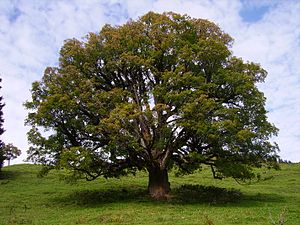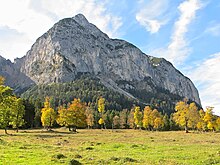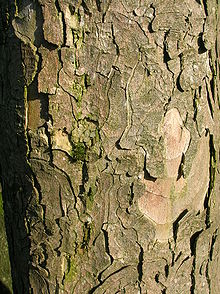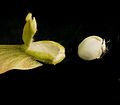Sycamore maple
| Sycamore maple | ||||||||||||
|---|---|---|---|---|---|---|---|---|---|---|---|---|

Sycamore maple ( acer pseudoplatanus ) |
||||||||||||
| Systematics | ||||||||||||
|
||||||||||||
| Scientific name | ||||||||||||
| Acer pseudoplatanus | ||||||||||||
| L. |
The sycamore ( Acer pseudoplatanus ) is a plant from the genus of maple ( Acer ). In order to emphasize its affiliation to the maple genus, the hyphen spelling is common in botany and not the otherwise common spelling sycamore. It is widespread in Europe and an important representative of its genus both as a park tree and in terms of forestry .
description
Vegetative characteristics
The sycamore maple grows as a deciduous tree that reaches heights of 8 to 30 meters. Single copies can be over 500 years old. As a solitary plant, it has an impressive shape with up-and-coming branches and a rounded crown . It is a deep rooter.
The smooth bark on the branches is light brown-gray and there are lenticels . The dark gray bark is weakly barked and flakes off flaky to flaky with advanced age. The appearance of the trunk is then similar to a plane tree .
The olive-green winter buds have bud scales that are ciliate on the edge.
The opposite arranged leaves are divided into a petiole and a leaf blade. The petiole does not contain milky sap. The leaf blade is up to about 20 centimeters long and usually 10 to 15 (8 to 20) centimeters wide and has five lobes, with the three middle lobes fully developed. Compared to the maple leaf lobes of the mountain maple are pointed shorter and not taken off the tips of the lobes in long, narrow lobes. The individual leaf lobes meet at an acute angle. The leaf blade is drawn in at the stem base. The upper side of the leaf is dark green and the underside is colored light gray-green to slightly purple. The leaf blade is slightly hairy on the leaf veins and in the nerve corners. The leaf margin is serrated to irregularly notched. The palmate, lobed leaves resemble those of the plane tree , as indicated by the specific epithet pseudoplatanus . The leaves of the wild form turn an intense golden yellow in autumn or reddish at high altitudes.
Generative characteristics
The sycamore maple is only capable of flowering (male) at the age of 25 to 40 years. The sycamore maple flowers in May when the leaves shoot or immediately afterwards. Many flowers stand together in terminal, overhanging, grape-like panicle inflorescences . The flower stalk is bare.
In principle, the flowers are hermaphroditic, with the male or female plants being suppressed on individual flowers of the same tree specimen. The yellow-green flowers are radial symmetry and five-fold.
The fruits ripen from late August to early October. The fruits are split fruits in which the two nuts are connected until they are ripe. The spherical wing nuts (Samara) each have one wing. The two wings of the split fruit are clearly arranged at an acute angle to each other (differentiation to the other maple species in Central Europe). There are long, silver-white hairs on the inside of the fruit peels.
The basic chromosome number is x = 26; there is diploidy with a chromosome number of 2n = 52.
ecology
With Acer pseudoplatanus is a phanerophytes .
Flower biology
The flowers contain a lot of nectar . Pollination occurs by insects and wind.
Propagation Biology
The wing nuts are typical helicopters with about 16 revolutions per second. They are often carried more than 100 meters by the wind.
Silviculture
In terms of silviculture, the sycamore maple is used as a valuable mixed tree species for soil improvement and ecological enrichment, in addition to the high value added at suitable locations. The strong heart root, created from branching of the taproot, opens up the soil well. It goes into the depths without branching out further. The leaves of all maple species rot into soil-care garbage . Sycamore maple naturally rejuvenates itself very well. As a pioneering tree species , it can develop raw soils, tilts and, thanks to its numerous fructification, also somewhat poorer soils .
Like the Norway maple, the sycamore maple is very fast-growing when young. After 10 years already about 4 meters high, after 20 years it can reach about 16 meters. The final height is around 35 meters. However, growth slows down relatively early on average locations, so that they are subsequently overtaken and overgrown by the common beech .
" Epiphytes " or epiphytes such as mosses and lichens use the sycamore maple as a base, especially in higher altitudes or in damp valleys, in order to better come to light. Since they do not enter the tree, they do no harm. Sensitive lichens such as beard lichens on the bark are a sign of high air purity.
Environmental influences and predators
The sycamore maple cannot tolerate prolonged drought or flooding. Sycamore maple is frost hardy , but young specimens are sensitive to late frosts. Young trees are gnawed by voles and game animals like to bite them too , so they often have to be protected from them.
Diseases
The particularly noticeable tar spot disease often occurs , in which the leaf sections infected by the parasitic fungus maple scab turn black. However, this disease does not kill the tree.
Habitat for insects
butterfly
The caterpillars of Willow Borer and Blue Sieve live in and from the wood of the sycamore maple . The caterpillars of the maple owl , maple wrench and hair flake moth live on the leaves .
Moths
The maple moth lives in rolled up leaves, the maple miner moth in the fruits. The maple moth caterpillar eats seeds first and leaves that have been spun together after overwintering. The horse chestnut leaf miner also uses the sycamore maple as a secondary host plant.
Beetle
The plaster beetle (alternative name: Spanish fly) feeds on leaves, its larvae develop in wild bee nests . The maple leaf roller makes funnel rolls from maple leaves for its youngsters. The larvae of several longhorn beetle species feed on dry or already rotten branches, twigs and root stumps of maple sycamore: maple Bock , Schwarzschwänziger Schmalbock , Colorful disc Bock , Keulenfüßiger check Bock . The beetle wood bark beetle also lives in the wood of sick trees .
Wild bees
In addition to honey bees, the very good nectar habit of the sycamore maple also attracts wild bee species such as the red-furry sand bee , the red-headed sand bee , the red mason bee and the horned mason bee from May to early June . According to studies by Paul Westrich , two types of furrow bees ( Lasioglossum ) and eleven types of sand bees ( Andrena ) also feast on the nectar in addition to the two types of mason bees ( Osmia ) mentioned .
More insects
In addition, the squirrel gall mite ( Aceria macrorhyncha ) and the larvae of the maple gall wasp ( Pediapsis aceris ) often live in the maple leaves.

Occurrence
The sycamore maple is widespread in Europe and Western Asia . There are localities for Germany , Denmark , Austria , Switzerland , Italy (including Sicily ), France (including Corsica ), Spain , Portugal , the former Czechoslovakia , Hungary , Poland , Belarus , the former Yugoslavia , Bulgaria , Romania , Moldova , Albania , Greece , Ukraine , Georgia and Ciscaucasia . It is absent in southern Spain and southern Greece.
In Central Europe it is the most common type of maple. As a tree of the cool and humid mountain climate, its main distribution points are in the middle and higher altitudes of the southern and central European mountains. In the low mountain ranges it is native to about 900 ( Harz and Erzgebirge ) to 1300 meters ( Bavarian Forest ), it reaches altitudes in the Northern Alps up to 1700 meters, in the Central Alps up to almost 2000 meters. The sycamore maple often climbs up to the high altitude level together with the rowanberry . In the Allgäu Alps, it rises to an altitude of 1500 meters. Together with the beech , it also occurs in the hill country and, together with ash and mountain elm, forms the so-called ravine forests (Aceri-Fraxinetum). He is in Central Europe a weak characteristic species of the association Tilio-Acerion and also comes in plant communities of the associations Fagion or Alno Ulmion ago.
Acer pseudoplatanus is a neophyte in many areas with a temperate climate , for example in Macaronesia, Australia, New Zealand, North America and Argentina. Due to its spreading strategy with the wing nuts, it is considered an invasive plant in some countries .
In the western part of the North German Plain , Scandinavia, Belgium and the Netherlands, the sycamore maple can only be found where it was brought by humans. There are no natural occurrences of the sycamore maple in Northern Europe and the British Isles , but it is often cultivated and then also occurs in the wild. In Denmark, the sycamore maple is also referred to as "Von Langen's footsteps" after the German forester Johann Georg von Langen , who is considered to be the founder of planned forestry in Denmark.

The so-called "maple soils" on alpine meadows were created through the promotion of the mountain maple by humans. Two particularly beautiful examples of this are the Großer and Kleiner Ahornboden in the northern Karwendel Mountains, popular destinations for day trips and hikes.
Taxonomy
The first publication of Acer pseudoplatanus was in 1753 by Carl von Linné in Species Plantarum , 2, page 1054.
Common names
The names of the sycamore maple, which are often only used regionally, exist or existed: Abhorn ( Old High German ), Acher ( Carinthia in the Lesachtal ), Achor ( Middle High German ), Achorn (Middle High German), Aehre, Aerle, Aernbaum, Afterahorn, Aharen (Middle High German ), Ahern (Middle High German), Ahören (Middle High German), Ahor (Middle High German), Ahoren (Middle High German), Ahorn, Ahre, Ahürn ( Mecklenburg ), Alhorn, Amhorn, Anchore, Anchorn, Anerle, Aorn (Middle High German), Arle, Arnholz ( Middle High German), Asthüren ( Transylvania ), Breitlöbere ( Austria ), Breitlobere, Buchéschern, Ehre ( Swabia ), Ehrenbaum, Ehrenholz, Einhorn, Engelköpfchenbaum ( Silesia ), Eschdorn, Wilder Feigenbaum, Flader (Middle High German), Fladerbaum (Middle High German), Gaisbaum, Klon ( Niederlausitz ), Lauterbaum, Lefelbum (Transylvania near Schäßburg ), Leimáhre, Großer Massholder, Milchbaum ( Alsace , Switzerland ), Milenbaum, Oehrn, Ohern (Middle High German), Ohorn ( St. Gallen ), Oho renbaum (Middle High German), Ohre, Pladerbóm ( Middle Low German ), Plederenbóm (Middle Low German), Spillholz ( Saxony ), Spindelholz (Saxony), Steinahre, Steinhre, Steinohre, Ure ( Bohemia , Ore Mountains ), Urle (Silesia), Urlenbaum (Silesia), Forest ash, grape leaf and vine leaves.
use
Wood
See main article: Maple wood
The sycamore maple has a rotation period of 120–140 years in forestry . A trunk diameter of 60 cm can be achieved after 120 years.
The wood is hard, but easy to work with and, due to its quality, is classified as a hardwood . Prices of several thousand euros can be achieved for high-quality logs. The maximum price for a French sycamore maple with locking was over 61,000 euros. The locking results from the wavy course of the fibers of the xylem and only occurs in 3% of the mountain maples. Barred maples are mostly obtained in small quantities from Tyrol, France, Scotland or Bosnia.
Already the pile dwellers of the Stone Age and Bronze Age often used the wood of the maple, but it is not particularly weatherproof. It is used for carpentry and turning work (tool handles, furniture, parquet floors, etc.). Bar maple is particularly popular. The well-known bird's-eye maple does not come from the sycamore maple and is only found in the North American sugar maple. This forms trunks with an unusually wavy grain, which makes the wood particularly decorative. A special use is the use as tonewood for the construction of musical instruments such as string instruments , plucked instruments and bassoons . Because of its elasticity and fine pores, maple is used in violin construction for the manufacture of the sides and because of its visual conspicuousness for the manufacture of the violin backs. The sound quality is largely due to the top, which is almost always made of fine-grained (ie the annual rings are close and evenly) spruce wood.
The Canadian sycamore maple wood is used for skateboard decks because of its hardness. For the production of the skateboards, several layers of the sycamore maple are colored and put together. This creates color samples as the layers wear off. Some small businesses use it to make decorative items.
Wood properties:
| Parameter | value | unit |
|---|---|---|
| medium bulk density (12% HF) | 623 | kg / m³ |
| modulus of elasticity | 9400 | N / mm² |
| Compressive strength | 58 | N / mm² |
| tensile strenght | 82 | N / mm² |
| Flexural strength | 112 | N / mm² |
| Fracture impact work | 62-65 | kJ / m² |
| Brinell hardness (0 ° fiber angle) | 62 | N / mm² |
| Brinell hardness (90 ° fiber angle) | 27 | N / mm² |
| Thermal conductivity | 0.16-0.18 | W / (m • K) |
Other uses
The sycamore maple offers relatively good noise protection on roads because of its large leaves, but is sensitive to road salt.
The bleeding sap of early spring was previously used for sugar production. The juice can also be fermented into a drink similar to must or wine .
The leaves can be used as fodder for sheep and goats and as bedding.
The flowers are a rich source of nectar in spring , which honey bees use. The honey they make from it, usually with dandelion nectar, is of excellent quality. Pure honey is only available in a few mountain locations with extensive mixed deciduous forests and there a high proportion of sycamore maple. This honey is light yellow, has a mild taste and aroma and crystallizes in a fine-grained, pasty manner. The bees can also collect abundant greenish pollen grains. With up to 25 million pollen grains per inflorescence, the sycamore maple is well ahead of the norway maple with 238,000 pollen grains.
As part of a thinning initiative, Deutsche Bahn is planting blood maple trees along its routes, because this stable, deep-rooted tree species minimizes the risk of falling over in a storm and thus blocking tracks.
Others
The maple from Trun , under whose crown the Gray Bund was founded in 1424 , became legendary . Members met under this tree to confirm the covenant until 1870, when a storm threw it. The broken stalk was carried into the courtroom of Chur in a funeral procession . Parts of the old trunk can now be seen in the Sursilvan Museum in Trun. Today there is a new maple tree in the same place, which was pulled from a cutting of the oath tree.
After the Norway maple was voted tree of the year in Germany in 1995, the sycamore maple received this honor in 2009. In Austria, the maple group (sycamore maple, Norway maple and field maple ) was voted tree of the year in 2005 .
The fruits and cotyledons and probably also the leaves of the sycamore maple are deadly poisonous for horses. The extent to which tar spot disease also plays a role in this so-called atypical pasture myopathy is not known.
The wing nuts are popular with children as "nasal picks".
sorts
There are several forms of selection (selection):
- 'Atropurpureum', also called blood maple, reaches heights of 12 to 18 m. The leaves are red when they shoot and the underside of the leaves is dark purple in color.
- 'Brillantissimum', grows as a 3 to 4 m high small tree or as a high trunk as a 5 to 6 m high spherical maple. The leaves turn from yellow to green after they appear pink.
- 'Erectum' is well suited for street planting because it is only 5 to 10 m wide at 15 to 20 m high.
- 'Erythrocarpum': The fruit wings are bright red.
- 'Negenia', grows with a pyramidal crown and becomes 20 to 25 m high and 15 to 20 m wide.
- 'Rotterdam' is 20 to 25 m high and 8 to 10 m wide than 'Erectum'.
literature
- Helmut Pirc: Maples . Eugen Ulmer, Stuttgart (Hohenheim) 1994, ISBN 3-8001-6554-6 .
- Egon Hoffmann: The maple. Forest, park and street tree. With photos by the author and drawings by Walter Schütte. VEB Deutscher Landwirtschaftsverlag, Berlin (East) 1960.
Individual evidence
- ↑ a b c d e f g h i j k Acer pseudoplatanus L., sycamore maple. In: FloraWeb.de.
- ↑ a b c d e data sheet at baumportal.de.
- ↑ a b c Thomas Meyer: data sheet with identification key and photos at Flora-de: Flora von Deutschland (old name of the website: Flowers in Swabia ).
- ↑ a b c d Description, use and cultural history - modified online edition by K. Häne, 2009: Tree of the year 2009. Der Bergahorn. Bündnerwald 62, 5, pp. 85–87.
- ↑ a b Olaf Schmidt: All about the "nasal pains". In: LWF Wissen, Volume 77, 2015_S. 61-64. PDF at lwf.bayern.de of the LWF = Bavarian State Institute for Forests and Forestry.
- ↑ a b Erich Oberdorfer : Plant-sociological excursion flora for Germany and neighboring areas. 8th edition, Verlag Eugen Ulmer, Stuttgart 2001, ISBN 3-8001-3131-5 , p. 647.
- ↑ Acer pseudoplatanus at Tropicos.org. In: IPCN Chromosome Reports . Missouri Botanical Garden, St. Louis
- ↑ a b c Helmut Hintermeier: Tree of the year 2009. Der Berg-Ahorn , in Allgemeine Deutsche Beekeeper newspaper , January 2008, page 31.
- ↑ Dr. Silvius Wodarz Foundation (ed.): The mountain maple. Tree of the year 2009 , Marktredwitz 2009.
- ↑ a b c Animal beneficiaries on the sycamore maple (PDF file 1.7 MB)
- ↑ The catalog of bees pasture plants in Baden-Württemberg, Sycamore , accessed on February 26, 2020
- ↑ a b c Acer pseudoplatanus in the Germplasm Resources Information Network (GRIN), USDA , ARS , National Genetic Resources Program. National Germplasm Resources Laboratory, Beltsville, Maryland. Retrieved October 12, 2018.
- ↑ Erhard Dörr, Wolfgang Lippert : Flora of the Allgäu and its surroundings. Volume 2, IHW-Verlag, Eching near Munich, 2004. ISBN 3-930167-61-1 , p. 206.
- ↑ CABI Invasive species compendium: Acer pseudoplatanus (sycamore). (Datasheet) The Center for Agriculture and Bioscience International (CABI), Wallingford, UK, accessed on October 12, 2018 .
- ↑ Acer pseudoplatanus at Tropicos.org. Missouri Botanical Garden, St. Louis, accessed October 11, 2018.
- ^ Carl Jessen : The German folk names of plants , published by Philipp Cohen Hanover 1882, page 4 f.
- ↑ Possibly the most expensive tree in Europe
- ↑ [1] Kunstkapitän.de - Two Hundred Seven: Upcycling Ideas from Skateboards (accessed: April 28, 2015)
- ↑ ÖNORM B 3012: Types of wood, names, abbreviations and characteristics . 1998, p. 6.
- ↑ Martin U. Müller , Gerald Traufetter: With blood maple against storm chaos. In: Spiegel Online . November 3, 2017. Retrieved November 12, 2017 .
- ↑ Doris Laudert: Myth Tree. 4th edition, BLV, Munich 2001, ISBN 3-405-15350-6 .
- ↑ Tree of the Year .
- ↑ Ahorn is tree of the year 2005 (notification from the Austrian Ministry of Life ).
- ^ Region: Beware of Sycamore Maple - Deadly for Horses ( Memento from November 11, 2013 in the Internet Archive ) on wdr.de from November 8, 2013, accessed on November 8, 2013
- ↑ Uwe Hörügel: http://www.tsk-sachsen.de/index.php/pferdegesundheit/84-bergahorn-als-ursache-fuer-die-atypische-weidemyopathie-kritische-zeit-estand-wieder-bevor ( Memento from November 27, 2013 in the Internet Archive ) at tsk-sachsen.de , accessed on November 8, 2013.
- ↑ a b Botanik Bochum - Acer pseudoplatanus (PDF; 1.3 MB).
- ^ University of Illinois - Acer pseudoplatanus 'Atropurpureum' -Purple-leaved sycamore maple .
- ↑ a b Tree of the year 2009 - the sycamore maple, an ecological portrait ( memento from February 18, 2009 in the Internet Archive ).
- ↑ Parks and Gardens | Thuringia - A park made of maple trees ( page no longer available , search in web archives ).
- ↑ Ecology in construction, PDF file, p. 32 ( page no longer available , search in web archives )
- ↑ a b c city and green 7/2006, p. 56
Web links
- Profile and distribution map for Bavaria . In: Botanical Information Hub of Bavaria .
- Acer pseudoplatanus L. In: Info Flora , the national data and information center for Swiss flora . Retrieved December 5, 2015.
- Comprehensive documentation on the properties and importance of the sycamore maple, also under the aspects of climate change. LWF Knowledge 62 - Sycamore Maple.
- The sycamore - International Year of Forests 2011 - Botanical Garden Mainz: Taxonomy, ecology, wood use and suitability by Dr. Ralf Omlor, April 27, 2011
- Sycamore at www.baumkunde.de .
- Tree of the Year 2009. The sycamore at www.wald.de .
- Gerhard Nitter: Profile with photos.
- Günther Blaich: data sheet with photos.
- Michael Hassler, Bernd Schmitt: Flora of Germany - A Picture Database , Version 3.62.
















